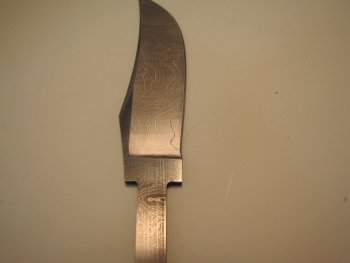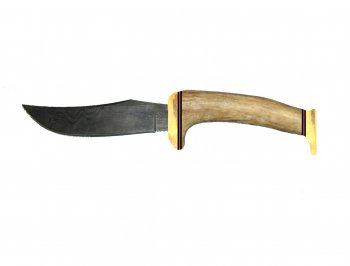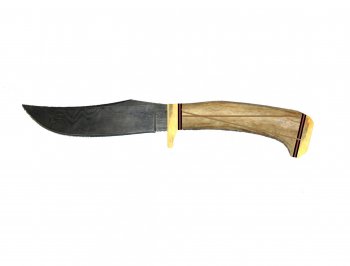JayDee70
Gold Membership
Made these two knives recently more or less at the customers direction but now want to make one for myself but really have no idea what I want. In making the Beast I found a de-lamination defect in the Damascus blade;
Look to the right just above the ricosso, I could catch a finger nail on the edges.

Call my vendor and they replaced the blade without question so now I have an extra blade that would be suitable for personal use but not for a customer.
I am thinking of doing something like this as a handle for it. The first pic is a current 'as-is', the second one is a photo-shop version of what I am thinking of doing. The guard and pummel shown would be from brass strapping, the colored lines would be vulcanized spacer material. I know that the curve of the guard goes against most of what I see but I wanted to give it a little curve and also keep the natural finger guard on the antler.


What do you think? Would appreciate any and all input. I don't know a lot about knives, yes I can put things together good but that doesn't necessarily need a lot of "knife know-how". If you suggest an idea I would appreciate some input on the why and even the how.
Thanks for looking, reading, and hopefully posting your thoughts.
Look to the right just above the ricosso, I could catch a finger nail on the edges.

Call my vendor and they replaced the blade without question so now I have an extra blade that would be suitable for personal use but not for a customer.
I am thinking of doing something like this as a handle for it. The first pic is a current 'as-is', the second one is a photo-shop version of what I am thinking of doing. The guard and pummel shown would be from brass strapping, the colored lines would be vulcanized spacer material. I know that the curve of the guard goes against most of what I see but I wanted to give it a little curve and also keep the natural finger guard on the antler.


What do you think? Would appreciate any and all input. I don't know a lot about knives, yes I can put things together good but that doesn't necessarily need a lot of "knife know-how". If you suggest an idea I would appreciate some input on the why and even the how.
Thanks for looking, reading, and hopefully posting your thoughts.
Last edited:


